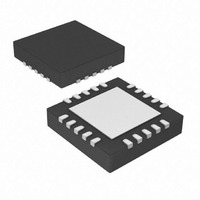PIC18F13K22-I/ML Microchip Technology, PIC18F13K22-I/ML Datasheet - Page 56

PIC18F13K22-I/ML
Manufacturer Part Number
PIC18F13K22-I/ML
Description
IC MCU 8BIT 8KB FLASH 20-QFN
Manufacturer
Microchip Technology
Series
PIC® XLP™ 18Fr
Datasheets
1.PIC18LF13K22-ISS.pdf
(388 pages)
2.PIC18LF13K22-ISS.pdf
(12 pages)
3.PIC18F13K22-ISS.pdf
(382 pages)
Specifications of PIC18F13K22-I/ML
Program Memory Type
FLASH
Program Memory Size
8KB (4K x 16)
Package / Case
20-VQFN Exposed Pad, 20-HVQFN, 20-SQFN, 20-DHVQFN
Core Processor
PIC
Core Size
8-Bit
Speed
64MHz
Connectivity
I²C, LIN, SPI, UART/USART
Peripherals
Brown-out Detect/Reset, POR, PWM, WDT
Number Of I /o
17
Eeprom Size
256 x 8
Ram Size
256 x 8
Voltage - Supply (vcc/vdd)
1.8 V ~ 5.5 V
Data Converters
A/D 12x10b
Oscillator Type
Internal
Operating Temperature
-40°C ~ 85°C
Processor Series
PIC18F
Core
PIC
Data Bus Width
8 bit
Data Ram Size
256 B
Interface Type
I2C, MSSP, SPI, USART
Maximum Clock Frequency
64 MHz
Number Of Programmable I/os
17
Number Of Timers
4
Operating Supply Voltage
1.8 V to 5.5 V
Maximum Operating Temperature
+ 125 C
Mounting Style
SMD/SMT
3rd Party Development Tools
52715-96, 52716-328, 52717-734, 52712-325, EWPIC18
Development Tools By Supplier
PG164130, DV164035, DV244005, DV164005
Minimum Operating Temperature
- 40 C
On-chip Adc
10 bit, 12 Channel
Lead Free Status / RoHS Status
Lead free / RoHS Compliant
Lead Free Status / RoHS Status
Lead free / RoHS Compliant, Lead free / RoHS Compliant
Available stocks
Company
Part Number
Manufacturer
Quantity
Price
Company:
Part Number:
PIC18F13K22-I/ML
Manufacturer:
SML
Quantity:
20 000
Part Number:
PIC18F13K22-I/ML
Manufacturer:
MICROCHIP/微芯
Quantity:
20 000
- Current page: 56 of 388
- Download datasheet (4Mb)
PIC18F1XK22/LF1XK22
4.5
The programming block size is 8 or 16 bytes, depend-
ing on the device (See Table 4-1). Word or byte pro-
gramming is not supported.
Table writes are used internally to load the holding
registers needed to program the Flash memory. There
are only as many holding registers as there are bytes
in a write block (See Table 4-1).
Since the Table Latch (TABLAT) is only a single byte,
the TBLWT instruction may need to be executed 8, or 16
times, depending on the device, for each programming
operation. All of the table write operations will essen-
tially be short writes because only the holding registers
are written. After all the holding registers have been
written, the programming operation of that block of
memory is started by configuring the EECON1 register
for a program memory write and performing the long
write sequence.
FIGURE 4-5:
4.5.1
The sequence of events for programming an internal
program memory location should be:
1.
2.
3.
4.
5.
6.
7.
DS41365D-page 56
TBLPTR = xxxx00
Read 64 bytes into RAM.
Update data values in RAM as necessary.
Load Table Pointer register with address being
erased.
Execute the block erase procedure.
Load Table Pointer register with address of first
byte being written.
Write the 8 or 16 byte block into the holding
registers with auto-increment.
Set the EECON1 register for the write operation:
• set EEPGD bit to point to program memory;
• clear the CFGS bit to access program memory;
• set WREN to enable byte writes.
Note 1: YY = x7 or xF for 8 or 16 byte write blocks, respectively.
Writing to Flash Program Memory
FLASH PROGRAM MEMORY WRITE
SEQUENCE
Holding Register
8
TABLE WRITES TO FLASH PROGRAM MEMORY
TBLPTR = xxxx01
Holding Register
8
Preliminary
Program Memory
TBLPTR = xxxx02
Write Register
TABLAT
The long write is necessary for programming the inter-
nal Flash. Instruction execution is halted during a long
write cycle. The long write will be terminated by the
internal programming timer.
The EEPROM on-chip timer controls the write time.
The write/erase voltages are generated by an on-chip
charge pump, rated to operate over the voltage range
of the device.
8.
9.
10. Write 0AAh to EECON2.
11. Set the WR bit. This will begin the write cycle.
12. The CPU will stall for duration of the write (about
13. Re-enable interrupts.
14. Repeat steps 6 to 13 for each block until all 64
15. Verify the memory (table read).
This procedure will require about 6 ms to update each
write block of memory. An example of the required code
is given in Example 4-3.
Holding Register
Note:
Note:
Disable interrupts.
Write 55h to EECON2.
2 ms using internal timer).
bytes are written.
8
The default value of the holding registers on
device Resets and after write operations is
FFh. A write of FFh to a holding register
does not modify that byte. This means that
individual bytes of program memory may be
modified, provided that the change does not
attempt to change any bit from a ‘0’ to a ‘1’.
When modifying individual bytes, it is not
necessary to load all holding registers
before executing a long write operation.
Before setting the WR bit, the Table
Pointer address needs to be within the
intended address range of the bytes in the
holding registers.
TBLPTR = xxxxYY
2010 Microchip Technology Inc.
Holding Register
(1)
8
Related parts for PIC18F13K22-I/ML
Image
Part Number
Description
Manufacturer
Datasheet
Request
R

Part Number:
Description:
Manufacturer:
Microchip Technology Inc.
Datasheet:

Part Number:
Description:
Manufacturer:
Microchip Technology Inc.
Datasheet:

Part Number:
Description:
Manufacturer:
Microchip Technology Inc.
Datasheet:

Part Number:
Description:
Manufacturer:
Microchip Technology Inc.
Datasheet:

Part Number:
Description:
Manufacturer:
Microchip Technology Inc.
Datasheet:

Part Number:
Description:
Manufacturer:
Microchip Technology Inc.
Datasheet:

Part Number:
Description:
Manufacturer:
Microchip Technology Inc.
Datasheet:

Part Number:
Description:
Manufacturer:
Microchip Technology Inc.
Datasheet:











